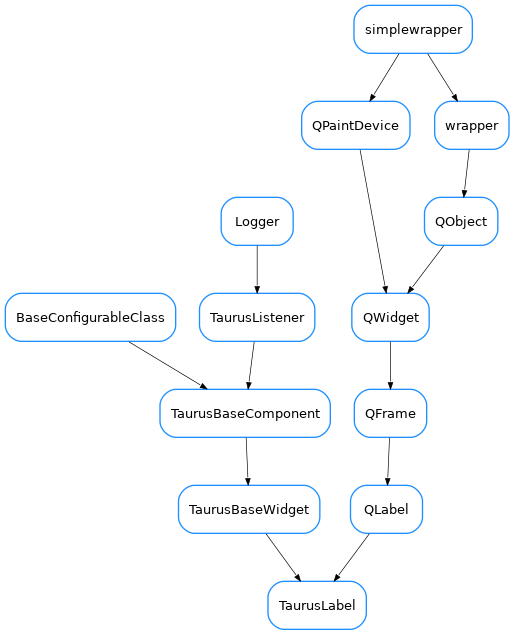TaurusLabel

- class TaurusLabel(parent=None, designMode=False)[source]
Import from
taurus.qt.qtgui.displayas:from taurus.qt.qtgui.display import TaurusLabel
- DefaultAlignment = <PyQt5.QtCore.Qt.Alignment object>
- DefaultAutoTrim = True
- DefaultBgRole = 'quality'
- DefaultFgRole = 'rvalue'
- DefaultModelIndex = None
- DefaultPrefix = ''
- DefaultShowText = True
- DefaultSuffix = ''
- autoTrim
Specifies wether the text will be trimmed when it doesn’t fit in the available space
Access functions:
- bgRole
This property holds the background role. Valid values are ‘’/’None’, ‘quality’, ‘state’
Access functions:
- dragEnabled
Specifies whether the user can drag data from this widget
Access functions:
TaurusLabel.isDragEnabled()TaurusLabel.setDragEnabled()TaurusLabel.resetDragEnabled()
- fgRole
This property holds the foreground role (the text). Valid values are:
‘’/’None’ - no value is displayed
‘rvalue’ - the value is displayed
‘wvalue’ - the write value is displayed
‘quality’ - the quality is displayed
‘state’ - the device state is displayed
Access functions:
- getFgRole()[source]
get the foreground role for this label (see
setFgRole())
- getModelIndexValue()[source]
Called inside getDisplayValue to use with spectrum attributes. By default not used, but some widget might want to support this feature.
Note
getModelIndexValue() is only supported for the default model key
Override when needed.
- getModelMimeData()[source]
Returns a MimeData object containing the model data. The default implementation fills the TAURUS_MODEL_MIME_TYPE. If the widget’s Model class is Attribute or Device, it also fills TAURUS_ATTR_MIME_TYPE or TAURUS_DEV_MIME_TYPE, respectively
- Returns:
MimeData object containing the model data.
- Return type:
QMimeData
- classmethod getQtDesignerPluginInfo()[source]
Returns pertinent information in order to be able to build a valid QtDesigner widget plugin.
The dictionary returned by this method should contain at least the following keys and values:
‘module’ : a string representing the full python module name (ex.: ‘taurus.qt.qtgui.base’)
‘icon’ : a string representing valid resource icon (ex.: ‘designer:combobox.png’)
- ‘container’a bool telling if this widget is a container widget or
not.
This default implementation returns the following dictionary:
{ 'group' : 'Taurus [Unclassified]', 'icon' : 'logos:taurus.png', 'container' : False }
- Returns:
a map with pertinent designer information
- Return type:
- handleEvent(evt_src, evt_type, evt_value)[source]
very basic and generalistic handling of events.
Override when necessary.
- isReadOnly()[source]
Determines if this component is read-only or not in the sense that the user can interact with it. Default implementation returns True.
Override when necessary.
- Returns:
whether or not this component is read-only
- Return type:
- model
This property holds the unique URI string representing the model name with which this widget will get its data from. The convention used for the string can be found here.
Access functions:
TaurusBaseWidget.getModel()TaurusBaseWidget.resetModel()
See also
- modelIndex
This property holds the index inside the model value that should be displayed
Access functions:
See also
- modelKeys = ['value', 'bgRole']
- prefixText
This property holds a prefix text
Access functions:
- setAutoTrim(trim)[source]
Enable/disable auto-trimming of the text. If trim is True, the text in the label will be trimmed when it doesn’t fit in the available space
- Parameters:
trim (bool)
- setBgRole(bgRole)[source]
Set the background role. The label background will be set according to the current palette and the role. Valid roles are: - ‘none’ : no background - ‘state’ a color depending on the device state - ‘quality’ a color depending on the attribute quality - ‘rvalue’ a color depending on the rvalue of the attribute - <arbitrary member name> a color based on the value of an arbitrary member of the model object (warning: experimental feature!)
Warning
the <arbitrary member name> support is still experimental and its API may change in future versions
- setFgRole(fgRole)[source]
Set what is shown as the foreground (the text) of the label Valid Roles are:
‘rvalue’ the read value of the attribute
‘wvalue’ the write value of the attribute
‘none’ : no text
‘quality’ - the quality of the attribute is displayed
‘state’ - the device state
- setModel(m, **kwargs)[source]
Sets/unsets the model name for the given key. If key is MLIST, a model is set for each name in the model sequence, new model keys are automatically added to the object’s
modelListattribute and the corresponding models are attached using those keys. The new keys are of the form(MLIST, i)whereiis the index of the corresponding model name in the model sequence.
- suffixText
This property holds a suffix text
Access functions:
- textInteractionFlags
Specifies how the label should interact with user input if it displays text.
Access functions:
- useParentModel
(deprecated))